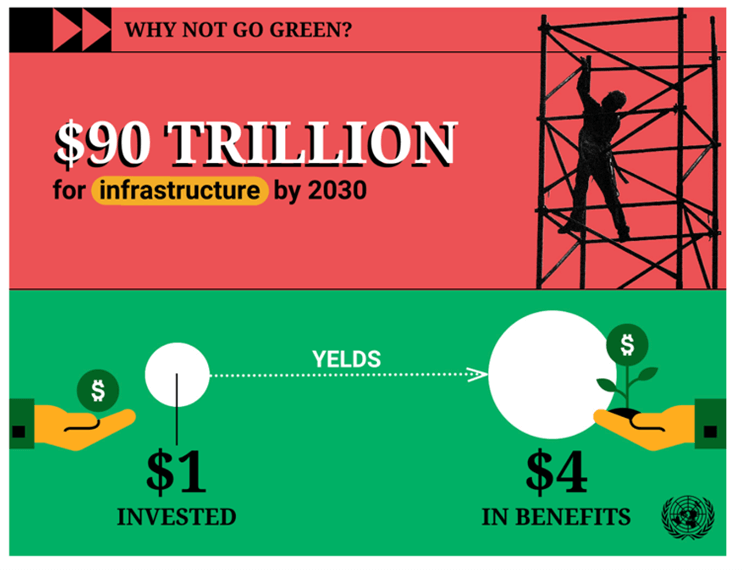
Dr Gabi Mocatta
Questions answered by this expert
This is such a good question and one that is quite tricky to answer accurately as there isn’t any exact global tally of money spent by all sectors on climate action. We only have estimates. It’s also difficult to tease out a separate figure for what industries spend, versus what governments spend. In addition to this, when we think of money spent on climate we need to think about what amount goes to mitigation and what’s allocated to adaptation. Here are some things we do know about global spending on climate change.
To transition to net zero by 2050, it is estimated that the world will need to spend about US$275 (A$428) trillion, an average of US$9.2 (A$14.3) trillion a year. We are currently far of this mark: we would need to increase annual spending by as much as US$3.5 (A$5.4) trillion from today. This figure is for spending on physical assets for energy and land use systems. We also need to consider how much money is spent on adaptation to climate change. The United Nations estimates that currently some US$50 (A$78) billion is spent on adaptation: a small fraction of what is actually needed. Rich countries pledged under the 2015 Paris Agreement to provide US$100 (A$155) billion a year to developing countries cope with damages from climate change. Unfortunately, this pledge has not been followed through, and climate finance to developing countries has fallen well short of the US$100 billion target since this initiative began.
It’s also important to think how much it would cost if we don’t invest in tackling climate change. It’s estimated that global economic losses from unmitigated climate change could be US$15.49 (A$24.1) trillion per year. In contrast, if we do invest in transition to net zero now, the global economy could see gains of US$43 (A$67) trillion between 2020 and 2070 and an overall boost of 3.8% to global GDP.
Where could money to deal with climate change come from? Research shows that the trillions of dollars needed to deal with climate change could come from redirecting current subsidies to sectors like the fossil fuel industry. It’s been estimated that US$7 (A$11) trillion a year in planet-damaging subsidies could be repurposed to combat climate change. Overall, it’s clear that that we only stand to benefit from spending on climate action now – and that as a global community we can afford it. In fact, we can’t afford not to.
Polling about climate change worldwide shows that most people understand climate change and are concerned about it. The largest ever survey to understand how people think about climate change and climate action shows that an average of 64% of people worldwide think that climate change is an emergency that needs rapid action. Despite this, there are still people who deny that climate change exists or that it needs to be urgently responded to.
There is some research that suggests that trying to win over “climate sceptics” with arguments about the irrefutable findings of climate science doesn’t really help convince them. It may even push them further into denial of climate change. If we are having a conversation about climate change with someone who doesn’t “believe” in climate change, we should try to be aware of what they value – and then speak about those things in relation to climate change.
This question also asks about some of the biggest ‘denier’ arguments, so let’s address those:
Climate change isn’t anthropogenic (caused by humans)
The argument here is that the climate has always changed and that current climate change is just a natural phenomenon. Decades of painstaking climate science show this is not the case. Putting more CO2 in the atmosphere causes the planet to heat. Atmospheric CO2 concentrations have fluctuated over geological time, but we know that over the past million years they have never been as high as they are today and that the current increase is definitely caused by human activity.
Climate scientists don’t agree that climate change is happening
This is not true. Research shows that 99% of publishing scientists who work in the area of climate change agree that climate change is happening now and that it is anthropogenic.
We can’t do anything about climate change (it’s too late)
It’s true that we have left it very late to take meaningful action on climate change – but it is not too late to make transformational change that will reduce the worst impacts of climate change. We can’t return to the climate of the past, but we can work towards the best possible future under climate change. We have no time to waste.
It’s been cold lately – that’s proof that climate change isn’t happening
Incorrect. This claim confuses weather and climate. Weather always fluctuates day to day. Climate is the long term average of weather. And that long term average is changing: the planet is definitely heating up. We know it has heated 1.1°C since pre0industrial times.
If you’d like to do some more reading and thinking about how to talk with climate change deniers, you can start with this excellent article by BBC.
The science of climate change is now settled. After decades of research on the causes and impacts of climate change, we understand what is causing the climate to change and what needs to be done about it. It is now social and political responses that are needed. And this is where politicians come in.
Politicians definitely do have power when it comes to decision making about climate change. This is the case at all levels of government: Federal, state and local. Governments can make laws and policies which could both reduce the harms being done to the climate and help us adapt to the changes that are already here. For example, in 2022, after years of not having a high enough emission reduction target the Australian Federal government legislated a 43% emissions reduction by 2030 which is a step in the right direction for getting us to ‘net zero’ emissions (no more emissions than can be absorbed or captured) by 2050. The Federal government has also set a goal for 82% of national energy to be from renewables by 2030. The problem is, just making legislation for mitigating climate change is not enough. It needs to be followed by action to help us get there. Right now, experts say Australia is not likely to meet either of these targets.
Unfortunately, governments also have power to take us in the wrong direction when it comes to tackling climate change. For example, in May 2023, the Northern Territory government approved the development of the Beetaloo Basin gas field. This huge methane gas reserve, when extracted and burned, will create enough emissions to undo much of Australia’s current emissions cuts. This is happening at a time when the International Energy Agency says there can be no new fossil fuel development if we are to reach net zero by 2050.
In democracies, elected government representatives are supposed work in ways that people want them to. We know that in Australia right now, over 80% of people are concerned about climate change and want to see climate action. There is a clear disconnect, then, between people’s climate concern and the pace and scale of government action on climate change. As citizens, we need to let politicians at all levels of government know that they aren’t acting urgently or significantly enough – and hold them accountable. How can we do this? Young people have taken out court cases against government and protested in the streets. We can join them. Also, join with an adult and write to your MP. Get involved in local climate mitigation and adaptation action. Get educated about climate change and use your vote for climate when the time comes.
Switching to renewable energy – especially wind and solar – is essential if we are to completely decarbonise the way we produce energy. Australia is lucky as we have particularly abundant renewable resources. We have really picked up the pace here in Australia on converting to renewable energy: 35.9% of Australia’s energy was generated by renewables in 2022, up from just 16.9% in 2017.
Yes, governments can and should lead the way, and they can do this by building new buildings that produce at least some of their own energy as well as ensuring existing buildings are very energy efficient, so they use less power. Multi-storey buildings, like government office buildings, often don’t have much roof space to accommodate rooftop solar panels. This is one reason why many government buildings don’t make their own power. But new types of solar energy technology now mean that multi-storey buildings can be clad all over with a “solar skin” like this proposed (non-government) building in Melbourne.

Some government buildings do have large roofs that are really suitable for generating all the energy they use, and more. For example, Australia’s airports – mostly federal government-owned buildings – have huge amounts of roof space that can accommodate large scale photovoltaic (or solar) systems. These can generate energy for the airport as well as thousands of homes and businesses. Other buildings with large roofs – for example, swimming pools which are often local government-owned – can produce more energy than they need for water heating and put power back into the grid.
One sector that is leading the way in getting government buildings to generate renewable power is – you guessed it – Australia’s schools. Schools all over the country are running solar fundraising campaigns and initiatives, like Solar My School in Sydney, some supported by local or state government. It’s bringing renewable power to thousands of classrooms with cost savings for the schools. It’s also a great learning opportunity for students to see how their school communities can lead the way in decarbonising and going renewable.
This is a great question about the cost of taking the action needed on climate change. This is something governments, economists and policy makers everywhere have been thinking about and calculating. It has also been something that those who would prefer to delay taking action on climate change have talked about a lot, saying that the costs of taking action are too large.
Certainly, the costs of decarbonising the global economy are great. The UN calculates that globally, US$125 trillion of investment is needed to achieve net zero by 2050. This is almost $200 trillion, in today’s currency, in Australian dollars. For perspective, about US$453 trillion (AU$720 trillion) of wealth exists in the global economy today. Most investment will be needed in technology for renewable electricity generation, so that we can move away from using fossil fuels for electricity. Currently, globally, we put US$600 billion (AU$953 billion) into decarbonising electricity. By the 2030s, this will need to be $2.2 (AU3$.5) trillion annually.
Related to the cost of decarbonisation, we need to think about the impact climate action would have on jobs. There are estimates that getting to net zero could mean the loss of 187 million jobs globally by 2050. However, there are also projected to be 202 million new jobs, given the need for new large-scale investment in renewable energy.
These are all large figures, that are hard to imagine, however, the best way to think about the cost of climate action is to set it against the cost of not taking action. We know unchecked climate change will mean more extreme weather disasters, reduce the amount of food the world produces, threaten infrastructure, raise insurance costs and claims and, force large numbers of people to migrate, all increasingly damaging economies. Although there is much difficulty and uncertainty about predicting a cost of inaction, one estimate is that not acting on climate change would cost US$178 trillion (AU$283 trillion) globally over the next 50 years. Research has been telling us ever more clearly that the costs of inaction are greater than the costs of action. By not acting, we will also miss out on the investment, innovation and jobs that the global transformation to clean energy will bring. Even more importantly, investing early in climate action will actually have economic benefits. The UN estimates that for every US1$ invested in the ‘green economy’ there will be $4 of benefits.

Therefore although we hear much about the cost of dealing with climate change, it’s wrong to say that the cost of acting to keep temperatures down is too much. In fact, it’s the other way around: if we act now we could be better off, globally, and if we delay action, dealing with climate change will cost us much more in the long run.










